Welcome to our comprehensive guide on Ceratopteris Siliquosa, the versatile aquatic fern that is perfect for your aquarium.
In this article, we will explore everything you need to know about this beautiful plant, from its defining characteristics and habitat to its care requirements and propagation techniques.
Whether you’re a beginner or an experienced aquarium enthusiast, this guide will provide you with all the information you need to incorporate Ceratopteris Siliquosa into your underwater world successfully.
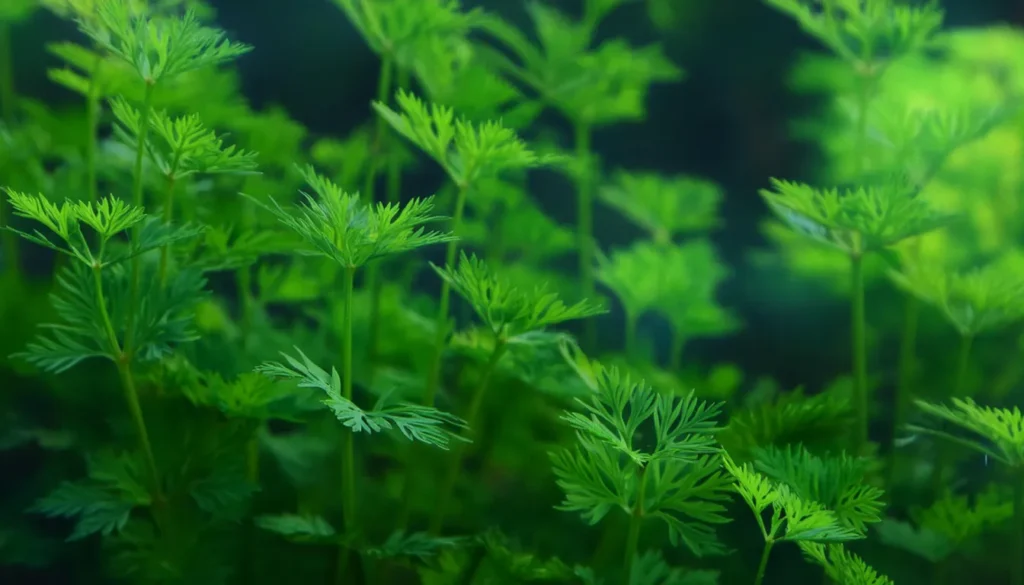
Key Takeaway
- Ceratopteris Siliquosa is a versatile aquatic fern that can thrive in your aquarium.
- Understanding the defining characteristics of Ceratopteris Siliquosa will help you provide the ideal care.
- Creating the optimal water conditions for Ceratopteris Siliquosa is crucial for its growth and well-being.
- Learning the planting techniques will enable you to incorporate Ceratopteris Siliquosa into your aquarium setup.
- Propagation techniques will allow you to expand your population of this beautiful aquatic fern.
Quick Stats
| Attribute | Details |
| Family Name | Pteridaceae |
| Origin | Tropical and subtropical regions worldwide |
| Height | 15-30 cm (6-12 inches), can grow larger under optimal conditions |
| pH Range | 5.0 – 8.0 |
| CO2 Requirement | Low |
| Growth Rate | Fast |
| Care Level | Easy |
| Color Form | Green |
| Water Conditions | 22-28°C (72-82°F), adaptable to a range of water hardness |
| Max Size | Can grow up to 30 cm (12 inches) or more |
| Lighting | Low to High |
| Supplements | Benefits from liquid fertilizer; CO2 optional |
| Placement | Can be used as a floating plant or anchored in substrate |
| Propagation | Adventitious plants from leaves or division |
What Is Ceratopteris Siliquosa?
Ceratopteris Siliquosa, also known as the aquatic fern, is a fascinating plant that adds beauty and depth to any aquarium. In this section, we will explore the defining characteristics, habitat, origin, and taxonomy of Ceratopteris Siliquosa to help you understand this unique aquatic fern.
Habitat And Origin
- Ceratopteris Siliquosa is native to regions with warm and tropical climates, such as Southeast Asia and parts of Africa.
- It thrives in freshwater habitats like rivers, streams, and swamps, where it can be found growing submerged or floating on the water’s surface.
- Its natural habitat provides valuable insights into the ideal conditions for cultivating Ceratopteris Siliquosa in your aquarium.
Physical Characteristics Of Ceratopteris Siliquosa
- Ceratopteris Siliquosa is known for its distinctive leaf structure and appearance. Its fronds feature delicate, feather-like leaves that create an elegant and graceful look in your aquarium.
- The leaves are typically green but can also have reddish or purplish tones, adding visual interest to your aquatic environment.

Optimal Water Conditions For Ceratopteris Siliquosa Growth
- pH Levels: The ideal pH range for Ceratopteris Siliquosa is between 6.5 and 7.5. It is important to regularly monitor and adjust the pH levels of your aquarium to ensure the optimal conditions for this fern’s growth.
- Water Hardness: Ceratopteris Siliquosa prefers moderately hard water with a hardness level of 3 to 8 dKH. Test the water hardness and make necessary adjustments to maintain the ideal conditions.
Lighting Demands
- Light Intensity: Ceratopteris siliquosa prefers moderate to high lighting levels. Providing sufficient light is essential for promoting healthy growth and vibrant foliage.
- Duration: Aim for a photoperiod of 8 to 10 hours of light per day. Consistent lighting schedules help mimic natural daylight cycles and support the plant’s metabolic processes.
- Light Spectrum: Ensure that the lighting system emits a balanced spectrum of light, including both blue and red wavelengths. Full-spectrum LED or fluorescent lights are suitable options for promoting optimal growth and coloration in Ceratopteris siliquosa.
- Adjustability: Consider using lighting fixtures with adjustable intensity settings. This allows you to fine-tune the light output according to the specific needs of Ceratopteris siliquosa and other aquatic plants in the aquarium.
Temperature Parameters For Robust Growth
- Temperature Range: Keep the water temperature in the range of 72°F to 82°F (22°C to 28°C) for optimal growth and health of Ceratopteris siliquosa.
- Ideal Temperature: Aim for a temperature around 78°F (25°C), which is comfortable for the plant and conducive to vigorous growth.
- Consistency: Maintain stable temperature conditions within the recommended range to prevent stress on the plant. Sudden fluctuations in temperature can negatively impact growth and overall plant health.
- Heating Equipment: Use aquarium heaters to regulate water temperature, especially in colder climates or during seasonal changes. Ensure the heater is appropriately sized for the aquarium volume and positioned to distribute heat evenly throughout the tank.
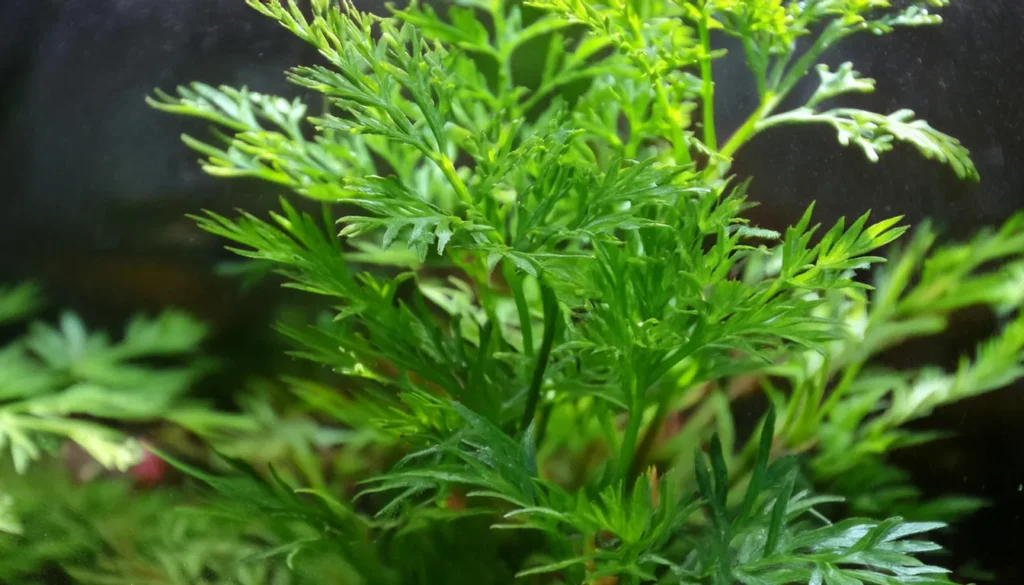
Rooting Into Substrate
To root Ceratopteris Siliquosa into the substrate of your aquarium, follow these steps:
- Prepare the substrate by ensuring it is clean and free of debris.
- Carefully place the plant’s roots into the substrate, burying them gently.
- Press the substrate firmly around the roots to secure the plant in place.
- Ensure that the rhizome (horizontal stem) is exposed and not buried in the substrate to prevent rotting.
- Provide adequate lighting and water conditions to promote healthy root growth.
Placement In The Tank
- Background or Midground: Indian Fern can be placed in the background or midground of the aquarium. Its tall, flowing fronds make it suitable for filling vertical space and creating a lush backdrop in larger tanks. Placing it in the midground allows the fern to serve as a transition between foreground plants and taller background species.
- Near Filter Outflows: Positioning Indian Fern near filter outflows can help simulate its natural habitat conditions. The gentle water movement created by the filter helps circulate nutrients around the plant, promoting healthy growth and preventing debris from settling on the leaves.
- Open Areas: Place Indian Fern in open areas of the aquarium where it has room to spread out and showcase its graceful foliage. Avoid crowding the fern with other plants or decor to allow it to fully develop and create a visually appealing focal point.
RELATED: IllumiCryptocoryne Spiralis Care Guide For Beginners
Recommended Tank Size
- Nano Tanks: Indian Fern can be suitable for nano tanks with capacities starting from 5 gallons. In smaller tanks, it can be used as a midground or background plant, providing lush greenery and vertical interest.
- Small to Medium Tanks: For tanks ranging from 10 to 50 gallons, Indian Fern can be utilized effectively as a midground or background plant, adding texture and depth to the aquascape. Its tall, flowing fronds can create a naturalistic backdrop for the tank.
- Large Tanks: In larger tanks exceeding 50 gallons, Indian Fern can be planted in multiples to cover larger areas and provide ample hiding places for fish and other tank inhabitants. Its graceful foliage can fill in open spaces and contribute to a vibrant underwater landscape.
Suitable Tank Mates
- Community Fish: Indian Fern is compatible with a variety of community fish species such as tetras, rasboras, danios, gouramis, and small catfish species like Corydoras. These fish typically inhabit different levels of the tank, allowing the fern to thrive without interference.
- Shrimp and Snails: Cherry shrimp, Amano shrimp, and various snail species like nerite snails and Malaysian trumpet snails are excellent tank mates for Indian Fern. They help to keep the aquarium clean by consuming algae and detritus while not causing any harm to the plant.
- Small to Medium-sized Cichlids: Certain small to medium-sized cichlid species, such as Apistogramma, keyhole cichlids, and dwarf cichlids, can coexist peacefully with Indian Fern, especially in larger tanks with ample hiding spots and territories.
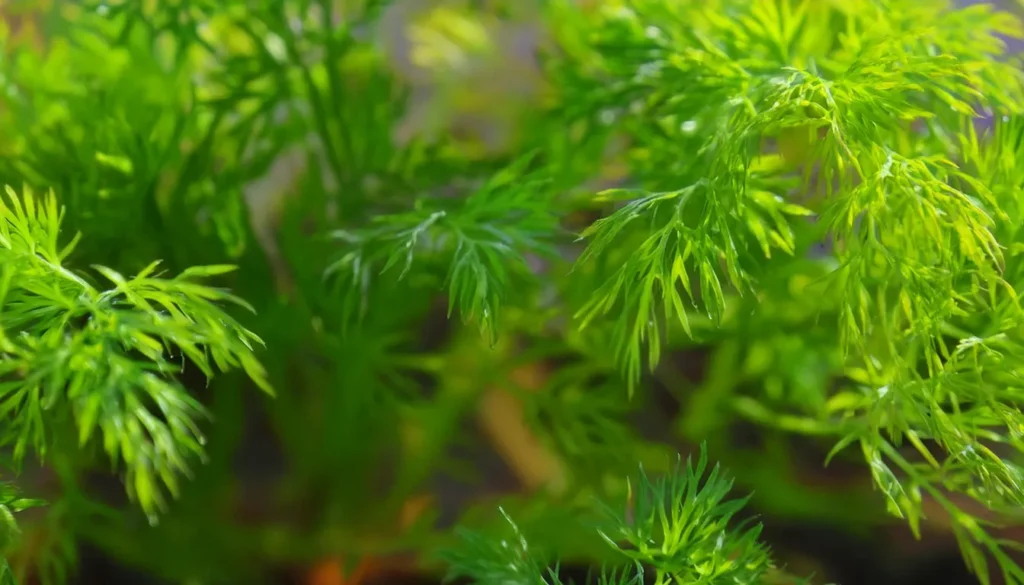
Nutrition Needs Of The Plant
Ceratopteris siliquosa, or Indian Fern, requires a balance of macro and micronutrients for healthy growth and development. Here’s an explanation of the micro and macronutrients essential for the plant:
Macronutrients
- Nitrogen (N): Nitrogen is a vital macronutrient required for the synthesis of proteins, enzymes, and chlorophyll. It plays a crucial role in promoting leafy growth and overall plant vigor.
- Phosphorus (P): Phosphorus is involved in energy transfer processes within the plant, including photosynthesis and cellular respiration. It also aids in root development and flowering.
- Potassium (K): Potassium regulates water uptake, osmotic balance, and enzyme activation in plants. It contributes to overall plant health, stress resistance, and nutrient uptake.
- Carbon (C): Carbon is obtained primarily from carbon dioxide (CO2) in the water and is essential for photosynthesis, the process by which plants produce energy and oxygen.
Micronutrients
- Iron (Fe): Iron is crucial for chlorophyll synthesis and photosynthetic activity. It also plays a role in enzyme activation and electron transport processes.
- Magnesium (Mg): Magnesium is a component of chlorophyll and is essential for photosynthesis. It also participates in various metabolic reactions within the plant.
- Calcium (Ca): Calcium is involved in cell wall structure, membrane integrity, and nutrient transport within the plant. It contributes to overall plant stability and growth.
- Manganese (Mn), Zinc (Zn), Copper (Cu), Molybdenum (Mo), and Boron (B): These micronutrients play essential roles as cofactors for various enzymes and metabolic processes in plants.
Cultivating Ceratopteris Siliquosa
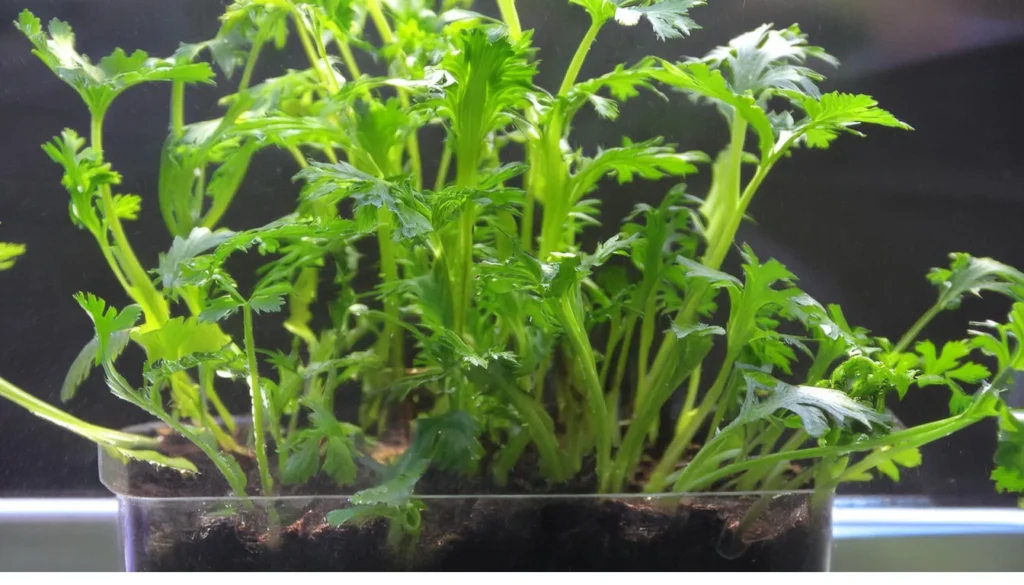
Cultivating Ceratopteris siliquosa, or Indian Fern, requires careful preparation, planting, and ongoing maintenance to ensure optimal growth and health. Here’s a guide to cultivating Indian Fern in your aquarium:
Preparation For Growth
- Ensure the aquarium is properly set up with appropriate lighting, filtration, and water parameters. Indian Fern thrives in moderate to high lighting conditions and prefers slightly acidic to neutral water with a temperature range of 72°F to 82°F (22°C to 28°C).
- Prepare a nutrient-rich substrate or attach Indian Fern to driftwood or rocks using fishing line or aquarium-safe glue. Ensure the substrate is deep enough to anchor the roots securely.
- If using Indian Fern as a floating plant, gently place it on the water’s surface, allowing its roots to dangle below. This method provides ample access to light and nutrients.
Planting and Initial Care
- Plant Indian Fern in the desired location within the aquarium, taking care not to bury the rhizome (horizontal stem) in the substrate. Burying the rhizome can lead to rot and hinder growth.
- Provide Indian Fern with sufficient light and water circulation to promote healthy growth. Ensure the plant receives gentle water movement to prevent stagnation and debris accumulation.
- Supplement with liquid fertilizers or root tabs to provide essential nutrients for Indian Fern’s growth. Monitor water parameters regularly and adjust fertilization as needed to prevent nutrient deficiencies.
Continued Maintenance
- Trim dead or yellowing fronds regularly to promote new growth and maintain the plant’s aesthetic appeal. Use sharp, clean scissors to avoid damaging the plant.
- Perform routine water changes to remove excess nutrients, debris, and organic matter from the aquarium. Indian Fern benefits from stable water conditions with low levels of dissolved organic compounds.
- Monitor for signs of nutrient deficiencies, algae growth, or pest infestations and take appropriate action to address any issues promptly. Ensure proper water quality and maintain a balanced ecosystem within the aquarium.
- Propagate Indian Fern by dividing the rhizome or allowing it to produce adventitious plantlets on the leaves. These plantlets can be carefully separated and replanted to expand your Indian Fern population or share with fellow aquarists.

Propagation Techniques For Ceratopteris Siliquosa
One method of propagating Ceratopteris Siliquosa is through adventitious plantlet propagation. To do this, follow these steps:
- Select a healthy and mature Ceratopteris Siliquosa plant.
- Gently remove the adventitious plantlets growing on the parent plant.
- Plant the adventitious plantlets in a separate location in your aquarium.
- Provide optimal water conditions and regular maintenance to promote their growth.
Another propagation method for Ceratopteris Siliquosa is stem-cutting propagation. Here’s how to do it:
- Select a healthy and mature Ceratopteris Siliquosa plant.
- Cut a section of the stem about 3-4 inches long using a clean and sharp pair of scissors.
- Remove the lower leaves from the stem cutting, leaving only a few leaves at the top.
- Plant the stem cutting in a suitable substrate in your aquarium.
- Maintain optimal water conditions and provide adequate lighting for the stem cutting to root and grow.
Ceratopteris Siliquosa Benefits
- Ceratopteris Siliquosa has positive impact on water quality. Like all aquatic plants, this fern performs photosynthesis, absorbing carbon dioxide and releasing oxygen. This helps to oxygenate the water, creating a healthier environment for your aquatic life.
- Furthermore, Ceratopteris Siliquosa actively removes excess nutrients from the water, such as nitrates and phosphates. Absorbing and utilizing these nutrients helps prevent algae overgrowth and maintains a balanced ecosystem.
- This makes it an effective natural filtration system, reducing the need for artificial filters and promoting optimal water conditions for your aquarium inhabitants.
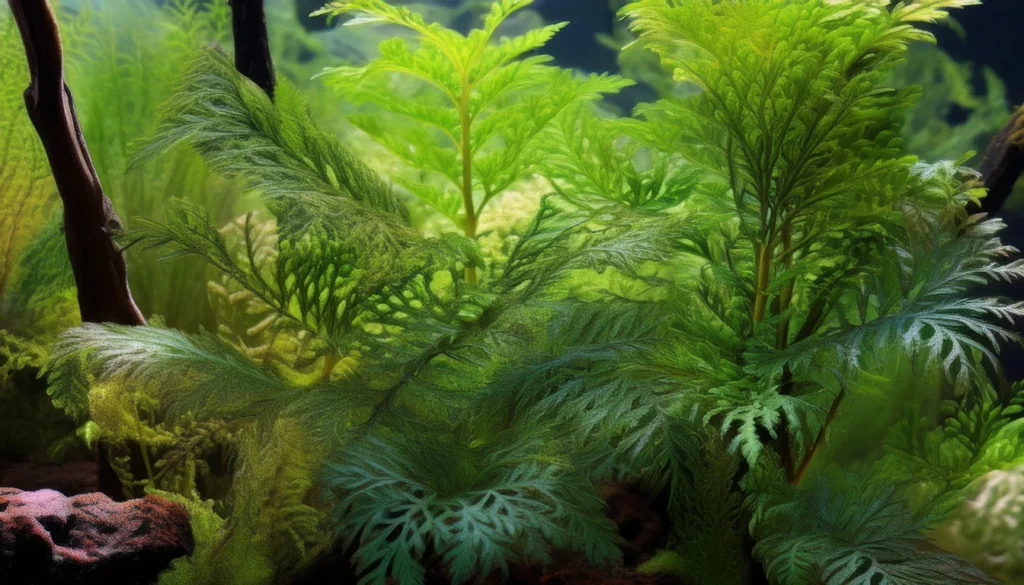
Conclusion
This guide has provided a comprehensive overview of Ceratopteris Siliquosa, a versatile aquatic fern that can enhance the beauty and health of your aquarium.
We have explored its defining characteristics, natural habitat, and taxonomy, giving you a deeper understanding of this fascinating plant. Following the care requirements outlined in this article can create an optimal environment for Ceratopteris Siliquosa to thrive.
Through our exploration of planting techniques and propagation methods, you have gained valuable insights into incorporating Ceratopteris Siliquosa into your aquarium.
Whether you choose to root it into the substrate or float it in the water, this aquatic fern will add a unique touch to your aquascape.
The benefits of including Ceratopteris Siliquosa are evident, from providing natural shelter to contributing to water quality.
Frequently Asked Questions
What Specific Conditions Enhance The Growth Rate And Health Of Ceratopteris Siliquosa In Planted Aquariums?
Ceratopteris Siliquosa thrives in a range of conditions, but optimal growth is achieved in water temperatures between 22°C to 28°C (72°F to 82°F), with a pH level of 6.0 to 7.5.
It benefits from moderate to high lighting (50 to 70 micromoles of PAR) and appreciates a nutrient-rich environment, particularly with a good supply of nitrogen and phosphorous.
CO₂ supplementation can significantly boost its growth rate and density, although it’s not strictly necessary. Soft to moderately hard water is ideal, though the plant is quite adaptable to various water hardness levels.
How Does Ceratopteris Siliquosa Contribute To Nutrient Control And Algae Prevention In Aquariums?
Ceratopteris Siliquosa is a fast-growing plant that absorbs a significant amount of nutrients, including nitrates and phosphates, from the water column.
This rapid uptake of nutrients can help outcompete algae for resources, reducing algae growth in the aquarium. Furthermore, by absorbing excess nutrients, it helps maintain a balanced ecosystem, contributing to clearer water and healthier conditions for fish and other aquatic life.
Regular pruning of this plant is necessary to ensure its continued efficiency in nutrient uptake and to prevent it from overshadowing other plants or taking over the aquarium.
Can Ceratopteris Siliquosa Be Grown Emersed, And If So, What Special Care Does It Require?
Yes, Ceratopteris Siliquosa can be grown emersed, transitioning from its aquatic form to develop broader leaves and a more robust structure when grown above water.
Emersed cultivation requires maintaining high humidity levels, around 80-90%, to prevent the leaves from drying out. The soil should be kept consistently moist but not waterlogged. Bright, indirect light or artificial lighting that mimics the natural spectrum is suitable for emersed growth.
Emersed Ceratopteris Siliquosa is often more vigorous and can produce spores on the underside of the leaves, which can be used for propagation.
What Are The Most Effective Propagation Methods For Ceratopteris Siliquosa, And How Can Aquarists Ensure Successful Growth From Spores Or Cuttings?
Ceratopteris Siliquosa propagates easily through two primary methods: spore cultivation and vegetative fragmentation.
For spore propagation, mature spores found on the underside of leaves can be harvested and sown on moist substrate in a high-humidity environment until they germinate and develop into new plants.
Vegetative propagation is simpler; it involves taking cuttings from the tips or sides of healthy plants and planting them directly into the substrate or letting them float until roots develop.
Both methods require adequate lighting and nutrient availability for successful growth. Keeping the water clean and maintaining stable conditions will support the health of newly propagated plants.
How Do Varying Water Conditions Impact The Leaf Morphology And Growth Habits Of Ceratopteris Siliquosa?
The leaf morphology and growth habit of Ceratopteris Siliquosa can vary significantly depending on water conditions. In softer, more acidic water with higher CO₂ levels, the plant tends to produce more delicate, finely branched leaves.
In harder, more alkaline water, the leaves may become thicker and less finely divided.
Light intensity also plays a crucial role; under stronger light, the plant grows more compactly with a denser leaf structure, whereas in lower light conditions, it may stretch towards the light source, resulting in longer stems and sparser leaves.
Adapting water conditions and lighting can help aquarists customize the appearance of Ceratopteris Siliquosa to fit the desired aesthetic of their aquarium.
- Unveiling The Wonders Of Riccia Fluitans In Aquascapes - August 7, 2024
- Vallisneria Gigantea Var. Guide To Care And Cultivation At Home - July 31, 2024
- Vesicularia Dubyana Care & Growth Guide Tips For Beginner Gardeners - July 30, 2024
